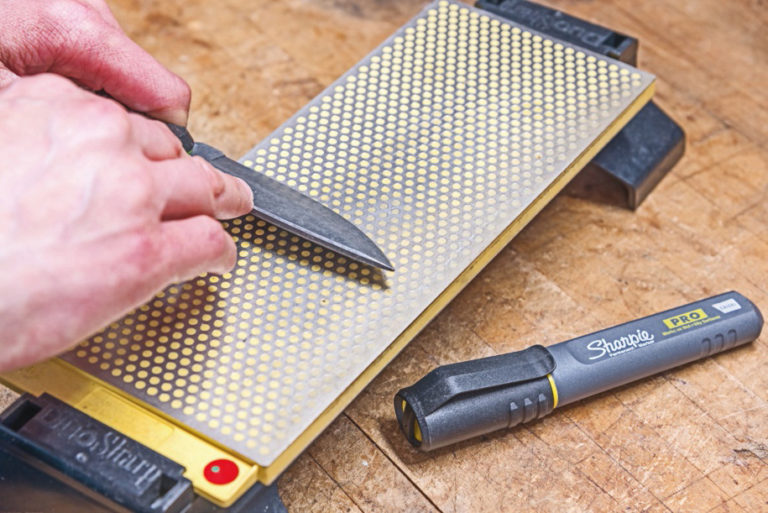
The best sharpening angle depends on the use of the knife, the thickness of the blade, the type of blade steel, the sharpening materials used and more.
What is the Best Sharpening Angle?
What determines the best sharpening angle? The answer is one that plagues knife neophytes and old hands alike.
“The best angle of sharpening is one of those very intriguing topics that many have explored but most have come up with different answers,” states Jake Broce, online marketing coordinator for A.G. Russell Knives.
Agrees Kyle Crawford, brand manager for Work Sharp, “The answer is often different for everyone.”
He says the two keys are knife type/use and edge retention/maintenance. In fact, all of our story sources cited the intended use of the knife as a deciding factor. For tough chores such as chopping or batonning, a wider angle is best.
“Generally, the wider the angle of edge, the more steel is behind it, which increases the edge’s toughness,” Broce observes.
“For kitchen knives that see light duty cutting food on cutting boards, or a task-specific hunting knife like a camping knife, a low angle is ideal,” counters Crawford.
By “low” he means an edge angle between 15 and 20 degrees.
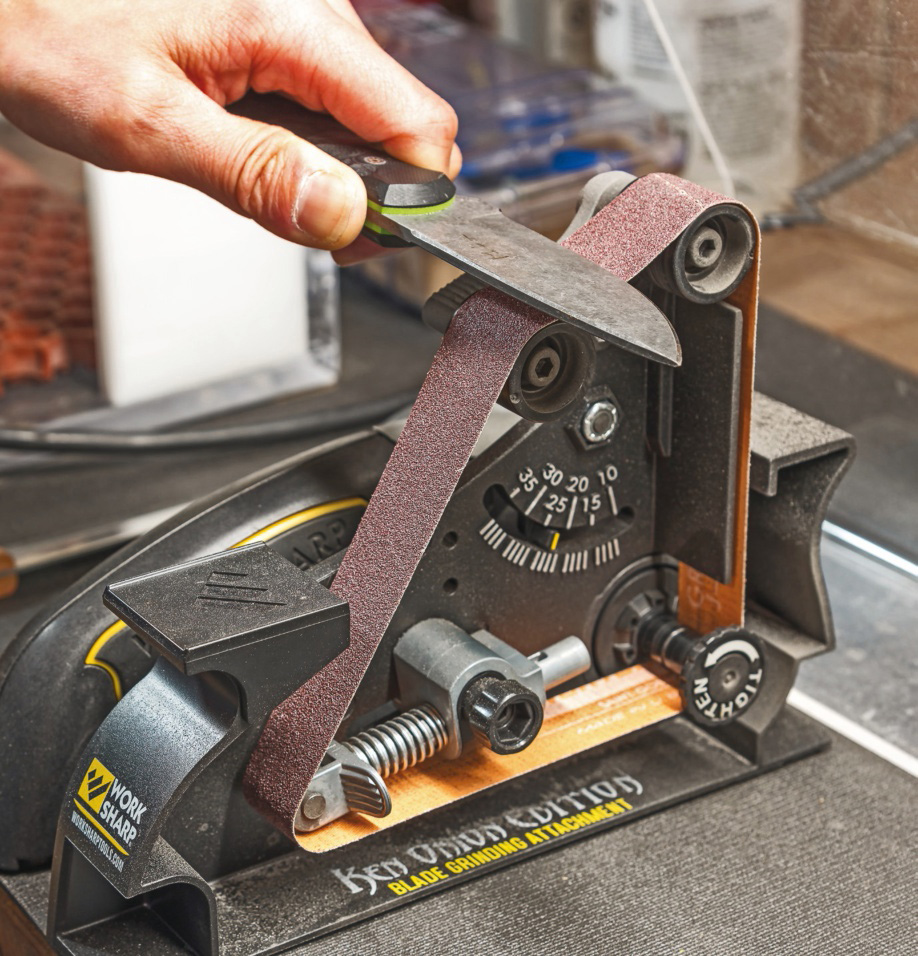
Edge angle also affects edge retention.
“If you sharpen your heavy-use EDC knife to a low angle such as 15 degrees, it will be incredibly sharp,” Crawford says, “but the trade-off you are making is edge retention and durability.”
Conversely, he adds, if you sharpen at a wider angle, such as 25 degrees, the edge will still be very sharp but you gain improved edge retention and, thus, eliminate the need for more frequent maintenance.
However, Kendra Tobler, marketing communications manager for Benchmade Knife Co., indicates grades of blade steel also factor in as well.
“A harder steel with higher yield strength can be ground to a small included angle with less worry about rolling or deforming the edge,” she says. “Conventionally cast steels with large carbides are better suited to larger included angles.”

This is done so for edge durability. A prime example of Tobler’s point is Benchmade’s 15017-1 Hidden Canyon Hunter, a compact drop-point fixed blade in premium CPM S90V stainless steel well known for its extreme edge-holding ability.
Benchmade uses its SelectEdge 14-degree included edge on the knife. It is ground thinner because S90V is a high-yield-strength steel that can retain its strength with a thinner edge without deforming or chipping.

Blade thickness is a factor as well.
“Thin blades are much easier to sharpen to low edge angles than thick knives,” Crawford states. “The thicker the blade, the more material you will have to remove to create a low edge angle.”
And it usually takes time to thin down a thick blade.
As he warns, “If you choose to sharpen a low edge angle onto a thick blade, be prepared to be patient.”
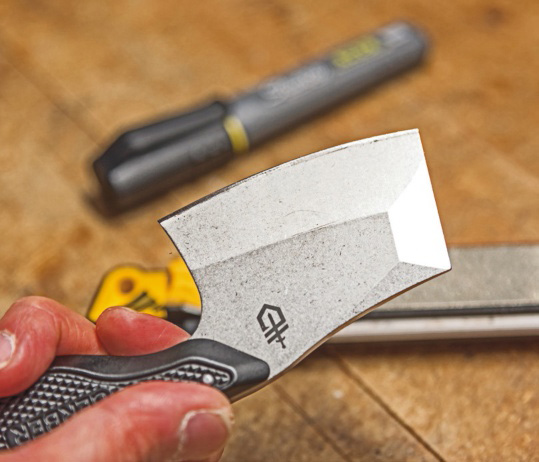
Establishing Angles
How should you go about establishing the edge angle when you sharpen? A safe bet is to invest in a sharpener that sets and maintains the edge angle for you—all you have to do is set the sharpener to the desired angle.
“Angle guides are tried and true and solve one of the biggest sharpening challenges—establish the angle and be consistent,” Crawford says.
Cautions Broce, “The first time you use [a guide kit] on your knife will usually take the longest, as your edge angle adjusts to the way you use the sharpener.”
The angle guide kits subtract the science of maintaining a consistent angle, so all you need do is concentrate on getting the edge sharp. The kits have been a game changer for consumers who struggle with freehand sharpening on a bench stone.

Another good tip, regardless of which sharpener you use, is the tried-and-true black marker trick. Using a permanent black marker with a wider chisel tip, color the edge bevel on both sides of the blade. The goal is to sharpen the blade, removing the black marker ink from both sides. When you accomplish this, your edge angle is correct and you should have a sharp blade.
“The goal is to remove all of the ink in one swipe,” Crawford says. “If you are removing the marker at the cutting edge, your edge angle is too high and you are micro-beveling.”
From there adjust your edge angle to a lower degree and take a few more passes to see how the ink is being removed.
“It is a process of trial and error,” Crawford notes.
Tobler is another proponent of the marker method. “It helps for matching the edge angle already on the blade when resharpening,” she observes.

You can use the method in conjunction with one of the guide kits even if the kit holds the angle constant for you. The method enables you to see how much more you must sharpen off in order for the edge bevel to be reestablished.
In this regard, you’re using it to determine how much more you have to go as opposed to if you’re holding the angle correctly.
Another tip is sharpen in a well-lighted area. Good visibility is very important and key to doing a thorough, well-executed sharpening job. And if you use the marker method a lot, abundant lighting helps you see clearer without eye strain.
Finally is sharpener selection. You can use any quality sharpener as long as it fits the steel type. The key here is to select a sharpener you feel very comfortable in using.
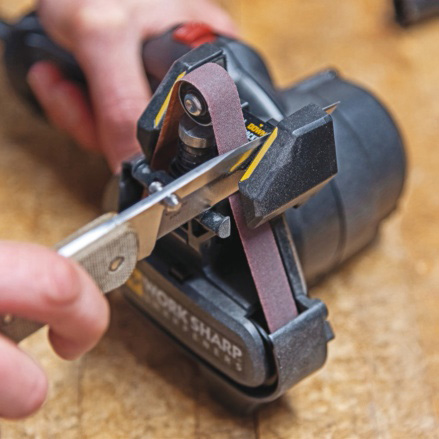
Knife Sharpening Safety
Sharpening can be dangerous, so be sure you are in the right frame of mind when you do it—not mentally or physically tired, nor pre-occupied. Focus on sharpening with little to no distractions.
Not only is your own personal safety at stake, but the more focused you are, the better job you can do. This is especially true if you’re learning a new sharpening technique, such as re-establishing edge angles.
Most of all, be safe, have fun and take satisfaction in the knowledge that, once you master establishing edge angles, you have become self-sufficient at sharpening.
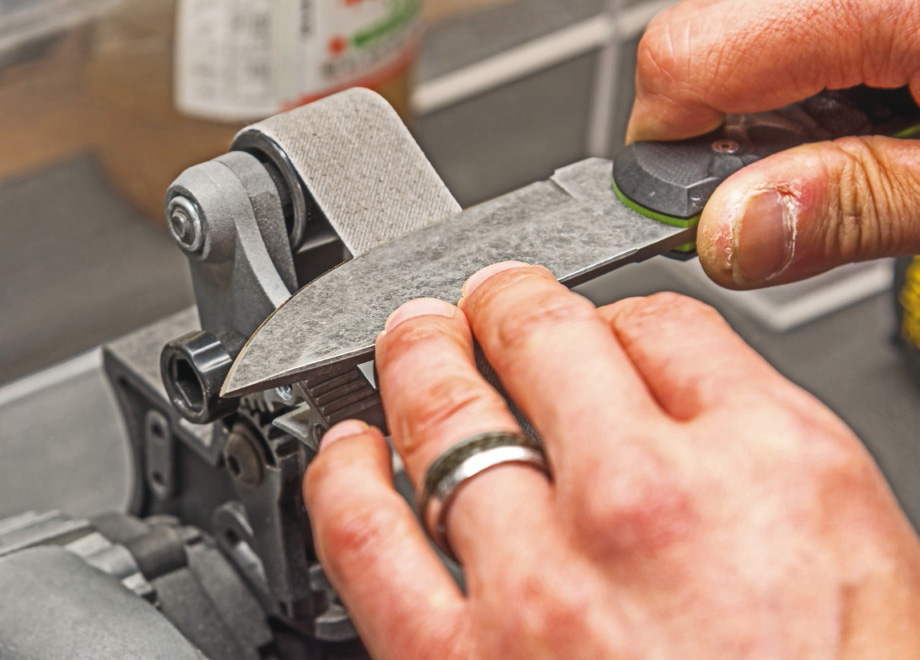
 NEXT STEP: Download Your Free KNIFE GUIDE Issue of BLADE Magazine
NEXT STEP: Download Your Free KNIFE GUIDE Issue of BLADE Magazine
BLADE’s annual Knife Guide Issue features the newest knives and sharpeners, plus knife and axe reviews, knife sheaths, kit knives and a Knife Industry Directory.Get your FREE digital PDF instant download of the annual Knife Guide. No, really! We will email it to you right now when you subscribe to the BLADE email newsletter.







Hello and thank you for this insightful article on knife sharpening angles and the role they play in our culinary experiences. The blend of technical expertise and practical application truly makes this a compelling read.
As an avid home cook, I couldn’t agree more with your points on how the sharpening angle impacts a knife’s performance. My personal journey with sharp knives has taught me that it’s not just about the visual appeal of a razor-sharp edge but also about the transformative effect it has on the cooking process. A sharp knife glides through ingredients, reducing the effort required and increasing the precision of each cut. For instance, peeling a vibrant, ripe tomato or dicing an aromatic onion becomes a task of joy rather than an arduous chore when a sharp knife is in hand.
The consideration of the blade’s intended use that you discuss is spot on. Equipping a kitchen knife with the accurate edge angle truly can make a huge difference in its overall effectiveness. It’s the harmony of the edge angle, edge retention, and blade toughness that dictates how a knife will perform its assigned tasks efficiently, enhancing the culinary experience.
Likewise, your detailed exploration of factors like blade thickness and material stresses the importance of an integrated approach when it comes to sharpening. A well-sharpened knife, taking into account all these variables, has a broader implication—it transforms the dynamic of the kitchen, replacing the strain of handling a dull knife with the thrill of effortlessly preparing dishes.
Moreover, your emphasis on safety and focus during sharpening serves as a vital reminder of the responsibility that comes with maintaining these crucial tools. It’s a facet of knife ownership that sometimes gets overlooked, but as you rightly point out, it’s key to ensuring both personal safety and optimal performance of the knives we entrust with our meals.
Finally, thank you for the practical tips on how to achieve the desired edge angle and optimally sharpen a blade. Resources like Just Knives often highlight the keep-your-knife-sharp principle, and your article supplements that knowledge with a comprehensive understanding of why and how.
In light of your expertise, I’m curious about how you’d recommend maintaining this optimal edge once it’s achieved? Would love to learn more about the routines or tips for preserving our knives’ sharpness over time.
Best regards,